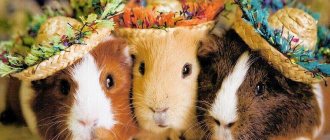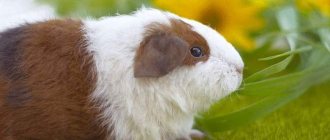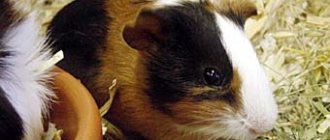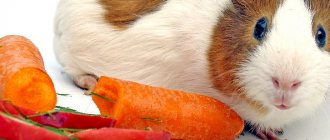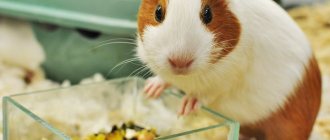Externally, the capybara is very similar to a guinea pig, only larger in size. An adult capybara can reach a length of 1-1.5. m. Males weigh 34-63 kg. Females, oddly enough, are slightly larger, their weight can reach 65.5 kg.
The capybara, despite its size, is a herbivore. The capybara has 20 teeth. No matter how many times a rodent loses cheek teeth, they quickly grow back. The rodent has short limbs. The body is covered with coarse hairs, there is no undercoat.
The capybara is found in South and Central America. It can be seen near warm shores.
The animal spends most of its time offshore, but if it is in any danger, it considers the water a safe place.
Capybaras live in groups of 10 to 20 individuals. One such family can occupy up to 10 hectares of land. Capybaras mark the boundaries of their territory.
The animals live 9-10 years, in captivity up to 12. Sometimes they are kept as pets.
The average weight of a simple domestic guinea pig usually does not exceed 0.8 kg, but in the wild it has large, similar relatives that reach 100 kg. These are the largest guinea pig in the world, called the capybara, and the giant guinea pig, the kui.
The largest guinea pigs
Large guinea pig - features of keeping cooi and capybaras
Many breeders are attracted to guinea pigs as pets. These rodents look quite cute, are easy to care for and have a very affectionate character. In any case, such an animal will delight you with its appearance and funny behavior, and pigs can easily be tamed and even taught some commands. However, for some it is not enough to have a rodent at home a little larger than a hamster; they want a large and massive pet, so they want to know what a large guinea pig is called.
Kui breed
Kui is one of the largest guinea pigs; the rodent differs from its relatives not only in its large dimensions, but also in its care, behavior and feeding. There are countries in which this animal is bred for its meat, while in others they make a wonderful pet. You should familiarize yourself with this animal in more detail in order to better understand its characteristics.
One of the largest breeds of guinea pigs
In terms of body structure, the giant pig resembles its smaller counterparts and is distinguished by a characteristic head shape, on which there are rounded ears and eyes with a rather intelligent look. Characteristic features include a massive chest, a short, stocky neck, and small front legs. On average, an adult reaches 55 cm in length, while its weight can be more than 4 kilograms.
The homeland of the animals is Peru; in this country, located in South America, you can find not only domestic but also wild cuis; they vary in size and color. These rodents are actively bred here for their tasty meat; it should be noted that it contains a large number of useful elements. The fertility of guinea pigs is impressive; in the first 4 months, the weight of a young pig exceeds 0.5 kilograms, so they are more profitable than even rabbits as pets. The state government is doing its best to popularize these animals as livestock - their maintenance does not require large financial investments, and they are also able to cope with starvation in poor areas of the country.
In some European countries, rodents are also bred for meat, but Europeans cannot afford to eat such animals every day, so it is more of a delicacy. Kui are used in their homeland as producers of high-quality fertilizer of natural origin; much less often they act as pets.
The distinctive features of these animals are not only their size, most of these rodents have about 5-7 toes on their paws, and each of them functions normally. They do not have a tail at all, but the fur can be coarse or soft, on average the length is not very long, it can be both straight and curly. Now there are very few breeders of this exotic pet, so there are not many varieties of colors and coat types; they resemble natural ones. To be more precise, the following colors of kui are common:
Boar. Sand. Dark brown. Light brown. White. Chocolate. Golden brown. Black. Piebald. Grey.
It should be noted that the character of kui is not the simplest, this can be explained by the fact that they are used exclusively for meat, and therefore are semi-wild. They are separated from other domestic animals because they are often aggressive towards other individuals, and towards their relatives in particular. Kui are always distrustful, cautious and frightened by any rustle. Representatives of the fairer sex are especially warlike, but in this case this expression is not about them at all, because when keeping several females in one cage, constant skirmishes and even fights cannot be avoided. Often such situations end in the death of one of the individuals. For this reason, the animals are not long-lived; in nature they live a little more than three years, and in captivity this time period doubles. It should be noted that males are much calmer.
Flanders
This is the name of one of the rabbit breeds. She was bred in Belgium. Flanders is one of the most famous and widespread breeds; exactly how it was obtained is not known exactly.
These rabbits are bred in many countries, and in each of them Flanders have their own characteristics. There are German, English, Spanish, etc. representatives of this breed. They did not take root in the USSR due to the harsh climate, but were used to breed the “gray giant” breed.
Flanders amazes with its size. They have a long body - up to 67 cm, high, thick and dense fur, color - gray or yellow-gray. Adult rabbits weigh 7 kg, some of them grow up to 10-12 kg, there are record holders weighing 25 kg.
Cui content
So we have determined the name of the largest guinea pig, but we should also determine the features of caring for such an unusual exotic animal. It should immediately be noted that rodents have a tendency to obesity, so patients with various diseases of the heart and circulatory system are common among them. Therefore, those who choose this rodent as a pet should carefully monitor its diet. Exceptionally fresh hay, vegetables and fruits. You can’t feed kuya with grains and mixed feed.
You should take a responsible approach to Kui's diet, as they are prone to obesity
Such an individual would be an ideal option for a nursery, because the female is capable of feeding 12 babies, and pigs can mate at just four months. It is important that the female becomes pregnant during her first heat, since then there is a high probability of obesity, as a result of which the likelihood of producing offspring will be significantly reduced. Gestation of the cubs continues for 2 months; at birth, the rodents are quite large, because their weight is 80-250 grams.
Features of the capybara
The capybara is rightfully the largest guinea pig. These wild rodents are not very different in appearance from their smaller relatives; in addition to the blunt-nosed square structure of the muzzle, they have the following distinctive features:
- strong and massive physique; large head with widely spaced nostrils; small eyes; short rounded ears.
Often such individuals reach 1.5 meters in length, while at the withers their size is 1 meter. On average, the mass of a capybara is about 60 kilograms, although there are larger individuals; among the weight record holders there are those whose mass is approximately 100 kilograms. Capybaras behave rather clumsily and mundanely, the fact is that the hind legs are much shorter than the front. They have a hard coat that fits tightly to the pet's body. In the wild, there are gray and red individuals, their shade may vary.
This is what Capybara looks like
You can see such animals in South America, namely in the tropics, and also in the Andes. Despite the fact that the rodent is terrestrial, it is located near bodies of water, since if there is danger, the rodent can easily hide in the water. Rodents unite in groups, each of them has certain pheromones and a certain territory, and they greet strangers very aggressively. The number of one herd is 10-20 individuals, headed by one male leader. They search for food during the day and hide in secluded places at night. This rodent eats plants; its diet may include aquatic and land vegetation.
Galago
Photo: depositphotos/ [email protected]
Saucer eyes, thick fur, fluffy tail, funny ears - this animal looks like it was drawn for a cartoon. A small primate called galago lives in dense, humid tropical forests in Africa. Sometimes these animals are found in savannas. They are very similar to loris lemurs, which are also very cute creatures.
Galagos weigh from 60 to 1,200 grams. They see perfectly in the dark because they are nocturnal. Funny primates live on the highest “floors” of trees. To sleep, they hide in dense foliage, choosing tangles of branches; they also build nests or use abandoned bird nests.
Galagos are very mobile, jumping along branches and the ground for considerable distances. The animal's ears can move at different angles, which gives it a special charm. Scientists have counted two dozen subspecies of galago. It is noteworthy that representatives of different subspecies cannot interbreed due to the different structure of the genital organs. And everyone has their own “language” - different sound signals. In addition, animals communicate using smells and even postures.
Galagos are not as harmless as they seem. Their diet includes more than just fruits. The animals are tough on eggs, invertebrates (including poisonous ones) and small vertebrates, as well as birds and small reptiles.
Capybara at home
This large guinea pig has a fairly friendly temperament, so it makes excellent contact with humans. Thanks to this, you can quite successfully keep a pet at home. In its homeland, the animal often lives with the local population; it is not particularly demanding to care for, but you still need to know a few features. However, the conditions for keeping a large individual are not much different from caring for its small relatives; the main thing is to provide the huge rodent with its own space. You need to purchase or make your own cage for your pet, where there should be a drinking bowl, bowls of food and filler. The capybara should take a free walk once during the day.
Nutrition does not have serious features and nuances; breeders of ordinary guinea pigs are familiar with this: vegetables, greens, hay, fruits and grains. The serving rate is calculated from the proportion, that is, per 1 kg of animal weight there are 50 grams of dry food and about 75 grams per 1 kg for juicy food. It is not at all necessary to limit the amount of hay, as well as water, since these components should be in excess.
Water procedures are contraindicated for ordinary decorative guinea pigs, but capybaras love to swim, they are ready to spend a lot of time in the water. If there is a swimming pool in a private house, then the capybara will feel just great. A guinea pig can survive underwater for more than 5 minutes, and its webbed fingers allow it to thrive in this environment, performing complex maneuvers and moving quickly.
The most famous capybara in the world is Caplin Rose, who lives in Texas. This rodent regularly appears on the main pages devoted to the life of animals and wildlife in general. The pig has a house for entertaining and feels comfortable even in a completely different climate, which is not very similar to the animal’s natural habitat. Guinea pig owner Melanie Tipaldos first met these animals in Venezuela. When her daughter picked up this rodent, the woman immediately fell in love with this cute and funny pet.
Due to its unique appearance and behavioral characteristics, the capybara can be included in the list of the most unusual and exotic pets, especially in our environment. Rose gets along well with people, doesn't mind being petted, and loves to travel in the back seat of a car. The owner of the animal actively shows the life of the animal on various social networks, for example, Facebook, Myspace and Twitter.
Lifestyle:
Lives both on land and in water. It can move away from the shore, but no more than 1 kilometer. The capybara is most often active during the day, but can become nocturnal if there is a threat from predators. Due to the high location of the organs of vision, hearing and smell, the capybara can keep them above the water when swimming. In hot weather, capybaras cover themselves in mud to prevent their skin from getting burned. Can choose a place to settle next to a person in order to steal crops from the fields. It does not build nests or beds for itself.
Capybara near the water
Giant Kui guinea pigs are the largest in the world.
Kui is the name of the largest guinea pig in the world. The dimensions of this giant pig correspond to the dimensions of an adult rabbit. In Latin American countries, the large rodent is bred as a farm animal. Its meat is used in the food industry. In Europe, the Kui guinea pig is kept as a pet. However, the large rodent is not as popular as its smaller relatives.
Spreading
The largest rodent in the world lives in almost all countries of Central and South America, preferring a tropical, humid climate and the obligatory presence of various bodies of water - rivers, lakes, ponds. Climatic conditions, namely seasonally constant, high air and water temperatures, determine the boundaries of the animal’s living area.
The climate data below for the year in Caracas (Venezuela) is necessary for the life of capybaras.
Air and water temperatures at 0C by month, number of rainy days:
| Jan. | Feb. | March | Apr. | May | June | July | Aug. | Sep. | Oct. | Nov. | Dec. |
| 22 | 22 | 24,5 | 25,5 | 25 | 26 | 26 | 27 | 28 | 27 | 26 | 25,5 |
| 24,5 | 24 | 25 | 24,5 | 26 | 26 | 26 | 28 | 28 | 28 | 27,5 | 26,5 |
| 3 | 4 | 7 | 14 | 18 | 19 | 19 | 26 | 27 | 26 | 18 | 13 |
The water pig also feels comfortable in wooded mountains (up to 1300 m in height) and in mangrove swamps.
Don't miss the most popular article in the section: Mariana Trench on the world map. Where it is located, what makes it unique, show what’s inside.
Origin
The countries of South America such as Peru, Bolivia, Ecuador and Colombia are considered to be the birthplace of the Cui breed. This rodent is a wild animal that lives in rocky and mountainous areas with abundant vegetation. The animals are grouped into flocks of 10 individuals, the main one among which is the healthiest, strongest and most resilient male.
Kui guinea pigs live in groups in South America.
Large guinea pigs in South American countries are farm animals that produce tasty, high-quality and inexpensive meat. The excrement of large rodents is used as a natural fertilizer, which is the additional value of kui.
Crested porcupine
It is often called the porcupine . The thick and stocky body of the animal is covered with dark and white needles. He has 2 types. There are long and flexible ones, growing up to 40 cm, and there are short and hard ones, 15-30 cm each, but differing in significant thickness.
The crested porcupine has a rounded muzzle with round eyes. He has short legs, he moves slowly, but he can also run. He uses his voice very rarely, only in moments of danger or irritation.
This is a very large rodent, growing up to 90 cm, plus a tail of 10-15 cm. Average weight is 8-12 kg, but some well-fed males weigh up to 27 kg.
Anatomy, appearance
The giant kui guinea pig, in comparison with other rodent species, has a massive skeleton and a wide cranium. Many individuals have extra toes on their paws, a defect called polydactylism. However, the abnormal fingers function and do not interfere with the rodent in any way. Giant guinea pigs have a weight ranging from 1.5 to 4 kg. The animal is prone to obesity, so it quickly gets fat.
The giant guinea pig Kui in the photo often has extra toes
As a result of breeding work, 2 subspecies of kui were bred: Creole ones are characterized by an elongated body, an elongated muzzle, but a wide forehead. Rodents are large, but gain weight slowly. The weight of an adult individual usually does not exceed 1.5 kg. A feature of the breed is its innate nervousness, which makes it difficult to increase the animal population. This breed was developed in Europe.
Improved ones are found mainly in Peru. Unlike individuals of the Creole breed, they have a less elongated muzzle. The rodent's skull is wide, with a massive forehead. The muscle mass of improved kui rapidly increases, so that by the age of six months the animal reaches the size of an adult. Body weight reaches 3-4 kg.
The Peruvian guinea pig Cuy in the photo has magnificent fur.
In turn, the improved breed of Kui guinea pigs is divided into several types:
- English has a short and smooth coat, the color of which varies from solid to spotted; Abyssinian is distinguished by a short coat with a large number of curls; The Peruvian has a cute appearance due to its long, smooth coat; Merino is characterized by a short and massive body, as well as tousled wool of short length.
Compared to other types of kui, representatives of the merino type are medium-sized. All Kui pigs have a short life expectancy due to a tendency to heart disease caused by obesity. On average, a large sea fish lives no more than three years.
Kui are guinea pigs with a difficult character. The animals are shy, nervous and unfriendly towards other pets, especially towards their own relatives. If a rodent owner decides to keep 2-3 females in one cage, then this will be a bad idea, since the guinea pigs will quickly fight.
Animal fights often end in severe injuries and even death.
Large guinea pigs grow quickly, becoming sexually mature at 3-4 months. Experienced rodent breeders try to breed a female animal during its first heat, since young rodents are less prone to obesity. Overweight rodents are not suitable for selection, since bearing offspring against a background of obesity can be fatal.
Important! Huge guinea pigs cannot be bred with representatives of other breeds, since as a result of improper selection, congenital anomalies occur in the offspring, manifested by numerous diseases.
Giant Kui guinea pigs grow very quickly
Soviet chinchilla
Despite the name, we are not talking about a chinchilla at all, but about a breed of rabbits that are bred for their fur. It was bred in the USSR. Our specialists crossed American chinchillas with different breeds and were able to increase the live weight of the animal to 5 kg.
In 1963, a new breed, the Soviet chinchilla, . Its representatives are distinguished by thick fur, high-quality skin, large size, good endurance and early ripening.
Their body is 60-70 cm long, they are silver or dark silver, the belly and part of the paws are black, and there is a border of the same color on the ears. An adult rabbit weighs from 3 to 5 kg, among them there are record holders who gained up to 7-8 kg.
Care and maintenance
The Kui pig is an uncommon pet. Their low popularity is due to the fact that it is difficult to find purebred representatives of the Kui breed in European countries. Another disadvantage of animals is their short life span and non-peaceful nature. If a person has decided to have a large guinea pig at home, he must know the peculiarities of feeding and keeping such an animal at home.
The pet needs a spacious cage, which is explained by its dimensions. Sawdust intended for filling rodent cages is used as bedding. Also, your pet needs to have a paddock for walking. Feed your pet in moderation, given his tendency to obesity. The Kui diet includes high-quality plant foods: freshly cut hay (grass), vegetables, herbs, unsweetened fruits, tree branches. It is forbidden to give cereals and mixed feed to rodents, since this food provokes obesity.
The Kui guinea pig needs a large room because it is larger than its domestic counterpart.
When keeping a large guinea pig, you should not ignore the care of its claws and fur. To keep the coat clean, the animal needs to be bathed once every 1-2 weeks, using a special shampoo. Once every six months, the rodent's claws are trimmed using special tweezers.
To keep your pet clean, you need to change the bedding in its cage at least three times a week. Ignoring this rule will result in a persistent unpleasant odor emanating from the animal. With proper care and feeding, a giant pig will be a healthy and active pet.
Nutrition
Capybaras prefer plants rich in protein. With their sharp teeth they seem to be cutting grass. The favorite foods of domestic capybaras are grains, fruits and vegetables, melons and sugar cane. If there is a lack of algae, rodents can eat tree bark.
Sometimes they do not disdain their own droppings; such food is easily digestible. In zoos, their diet is somewhat different. There they are given special granules for rodents and various vitamin complexes.




